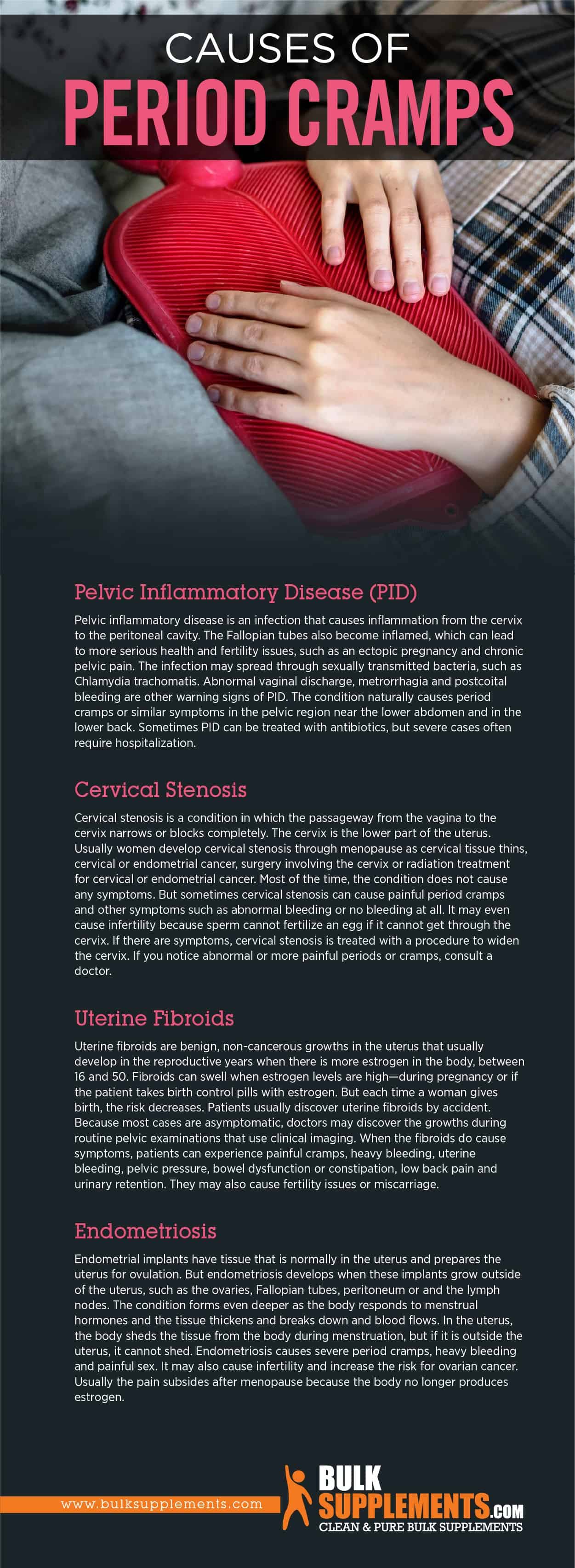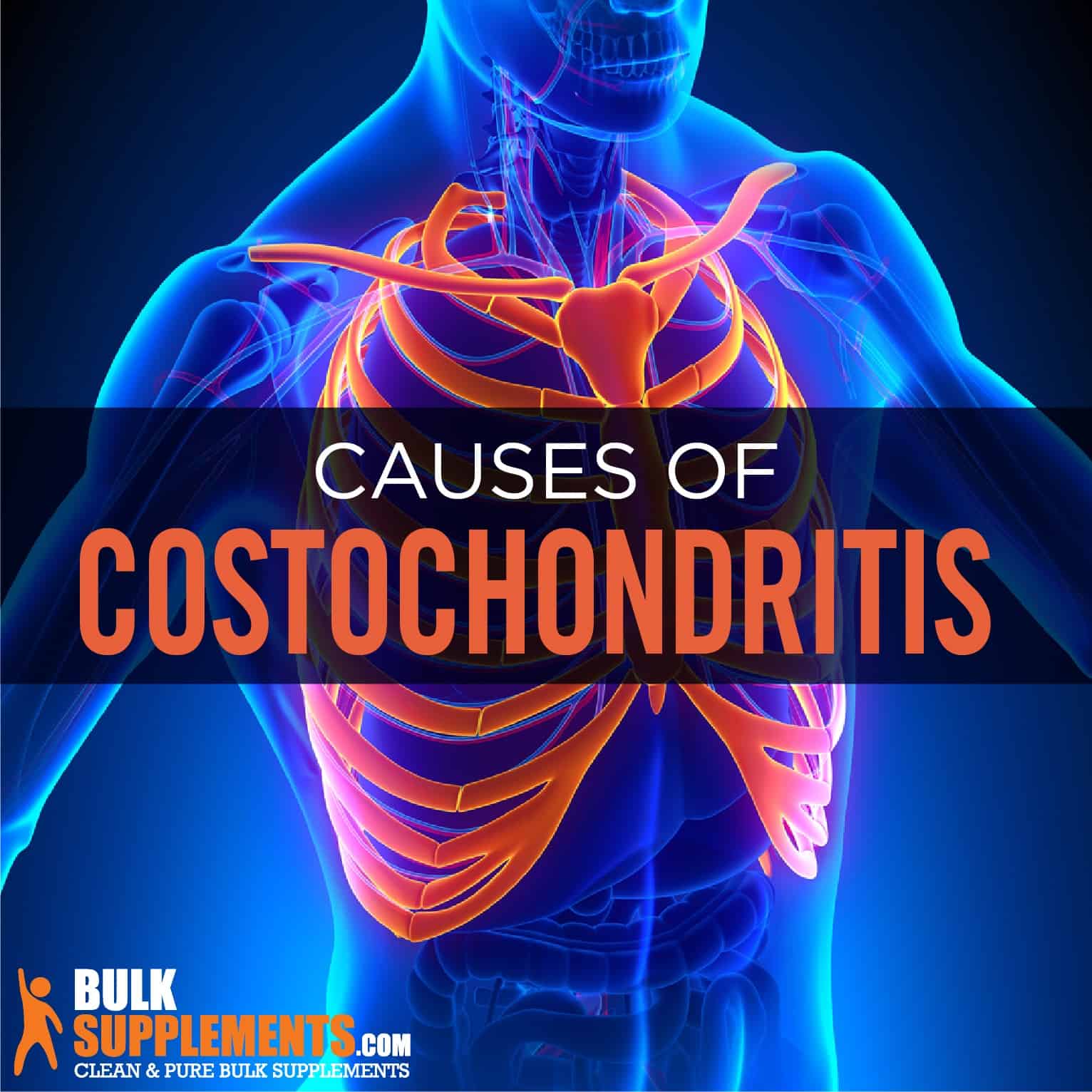Period Cramps: Causes, Symptoms & Remedies

Period Cramps
What are Period Cramps?
Period cramps are also called menstrual cramps or dysmenorrhea. The cramps present a throbbing or cramping pain in the lower abdomen, specifically before and during menstruation. Most women experience some degree of cramping during their menstrual cycles, but some women experience severe period cramps that interfere with their everyday activities.
Menstrual cramps generally ease with age and sometimes even after pregnancy and childbirth. Continuous period pain may be a sign of a more serious and identifiable medical condition. For example, pelvic inflammatory disease, endometriosis, uterine fibroids and cervical stenosis can cause pain that mimics period cramps. The pain associated with these conditions are called secondary dysmenorrhea, whereas pain that is only associated with menstruation is called primary dysmenorrhea.
There are several over-the-counter medications and natural supplements that can help relieve period pain, such as chamomile, fennel and ginger.
Causes of Period Cramps
Period cramps are a common symptom of menstruation and ovulation. Prostaglandins are chemicals in the uterus lining and because of these chemicals, the uterus expels its lining every month if there is no sperm in the body to fertilize an egg. The prostaglandins cause the muscles in the uterus to contract, causing blood flow to the uterus lining and painful cramps in the lower abdomen.
Although painful and sometimes inconvenient, period cramps are a natural occurrence and they are simply the body’s way of adapting to and dealing with the menstruation process. Most of the time they only last between two and four days and show up one or two days before the cycle begins. The pain may be mild or severe, but it usually abates with age. However, if the symptoms get noticeably worse or start after age 25, it may be a sign of something more serious and it wouldn’t hurt to seek medical attention. More serious causes of period pain can include pelvic inflammatory disease, cervical stenosis, uterine fibroids and endometriosis.
Pelvic Inflammatory Disease (PID)
Pelvic inflammatory disease is an infection that causes inflammation from the cervix to the peritoneal cavity. The Fallopian tubes also become inflamed, which can lead to more serious health and fertility issues, such as an ectopic pregnancy and chronic pelvic pain. The infection may spread through sexually transmitted bacteria, such as Chlamydia trachomatis. Abnormal vaginal discharge, metrorrhagia and postcoital bleeding are other warning signs of PID. The condition naturally causes period cramps or similar symptoms in the pelvic region near the lower abdomen and in the lower back. Sometimes PID can be treated with antibiotics, but severe cases often require hospitalization.
Cervical Stenosis
Cervical stenosis is a condition in which the passageway from the vagina to the cervix narrows or blocks completely. The cervix is the lower part of the uterus. Usually women develop cervical stenosis through menopause as cervical tissue thins, cervical or endometrial cancer, surgery involving the cervix or radiation treatment for cervical or endometrial cancer. Most of the time, the condition does not cause any symptoms. But sometimes cervical stenosis can cause painful period cramps and other symptoms such as abnormal bleeding or no bleeding at all. It may even cause infertility because sperm cannot fertilize an egg if it cannot get through the cervix. If there are symptoms, cervical stenosis is treated with a procedure to widen the cervix. If you notice abnormal or more painful periods or cramps, consult a doctor.
Uterine Fibroids
Uterine fibroids are benign, non-cancerous growths in the uterus that usually develop in the reproductive years when there is more estrogen in the body, between 16 and 50. Fibroids can swell when estrogen levels are high—during pregnancy or if the patient takes birth control pills with estrogen. But each time a woman gives birth, the risk decreases. Patients usually discover uterine fibroids by accident. Because most cases are asymptomatic, doctors may discover the growths during routine pelvic examinations that use clinical imaging. When the fibroids do cause symptoms, patients can experience painful cramps, heavy bleeding, uterine bleeding, pelvic pressure, bowel dysfunction or constipation, low back pain and urinary retention. They may also cause fertility issues or miscarriage.
Endometriosis
Endometrial implants have tissue that is normally in the uterus and prepares the uterus for ovulation. But endometriosis develops when these implants grow outside of the uterus, such as the ovaries, Fallopian tubes, peritoneum or the lymph nodes. The condition forms even deeper as the body responds to menstrual hormones and the tissue thickens and breaks down and blood flows. In the uterus, the body sheds the tissue during menstruation, but if it is outside the uterus, it cannot shed. Endometriosis causes severe period cramps, heavy bleeding and painful sex. It may also cause infertility and increase the risk for ovarian cancer. Usually the pain subsides after menopause because the body no longer produces estrogen.

Accompanying Symptoms of Period Cramps
In addition to painful cramps, menstrual periods can cause other symptoms including:
Lower Back Pain
Menstruation may also cause pain in the back. The pain is caused by contractions in the uterus during menstruation that spread throughout the pelvic area. When the body tries to get rid of the uterine lining, it puts pressure on the blood vessels in the pelvic region and limits oxygen to muscles in the back or thighs, causing pain. The cramps usually begin a few days before the cycle begins and can last for a few days after it ends.
Headaches
Another common characteristic of menstruation is headaches. The severity of the headache differs based on the individual, but generally they begin a few days before the period. Headaches at the beginning of the cycle are called menstrual migraines. Before the menstrual period starts, estrogen levels drop and it increases the risk of migraine, possibly because estrogen helps the brain perceive pain and without it, the brain has a harder time reducing pain.
Nausea
Nausea is a common symptom that accompanies period cramps. It is the body’s gastrointestinal response to the pain. The body releases the chemical prostaglandin during the menstrual period and it enters the bloodstream, causing nausea, vomiting, diarrhea and headaches. Hormones may also fluctuate during menstruation and the stomach may produce more gastric juices that induce nausea. Menstrual migraines may also trigger the feeling.
Other characteristics include bloating, fatigue, pain in the legs and hips, diarrhea and mood changes.
Remedies for Period Cramps
Medication
There are various over-the-counter medications that may effectively treat menstrual cramps. For example, anti-prostaglandins can ease cramps and blood flow and nonsteroidal anti-inflammatory drugs can relieve pain.
Birth Control Pills
Sometimes physicians prescribe hormonal birth control pills that reduce cramps by preventing ovulation. The hormones in the pills affect the uterine lining, making it thinner in order to reduce cramps and blood flow.
SEE ALSO

Costochondritis: Causes, Symptoms & Treatment
Home Remedies
Exercise and massage therapy are two natural ways that may help relieve period cramps. Applying heat to the abdomen with a hot water bottle or soaking in a hot bath is another form of relief and relaxation. Massaging essential oils such as lavender or chamomile to the abdomen may help ease pain. Masturbation or orgasms can also help relieve period pain.
Supplements for Period Cramps
Some supplements derived from natural sources may help relieve menstrual pain. However, supplements are not a replacement for actual medical treatment. Always consult with a doctor before taking supplements and follow a doctor’s instructions for dosage and use.
Chamomile
Chamomile supplements and chamomile tea are excellent herbal remedies to ease period cramps. Glycine is a chemical compound commonly found in chamomile tea and research shows that glycine can relax tension in the nerves that cause contractions and relieve pain. Chamomile tea also contains hippurate, which helps fight infections and may prevent complications. The recommended dosage for chamomile extract is 800 mg once or twice a day, as needed.
Ginger
Ginger has been used as a pain-relieving herbal treatment for centuries, but it is also an excellent anti-inflammatory and can help fight inflammation during menstrual periods. It can also reduce menstrual bleeding. However, the supplement may cause mild side effects such as heartburn or abdominal discomfort. As a dietary supplement, take ginger root extract in 1,000 mg doses once a day with water to avoid heartburn.
Fennel
With a distinct fragrance, fennel and fennel seeds are a natural remedy that may help relieve period cramps by relaxing the uterus. They may also act as a natural replacement for painkillers. However, it is important to speak with a doctor before taking this supplement. The recommended dosage for fennel extract powder is 1,000 mg once or twice a day.
The Bottom Line
Period cramps, otherwise known as menstrual cramps or dysmenorrhea, cause pain in the abdomen before or during menstruation. During the cycle, the uterus sheds its lining, causing blood flow and the muscles to contract, which causes cramps in the lower abdomen. It may also cause pain in other areas around the pelvic region, such as the lower back, hips and thighs.
Menstruation can cause other accompanying characteristics, such as headaches, nausea, bloating and fatigue. Period cramps are a natural symptom of menstruation, but sometimes they can indicate more serious conditions like pelvic inflammatory disease, cervical stenosis, endometriosis and uterine fibroids. If period pains get worse or begin after age 25, consult a doctor to rule out any medical conditions.
Period cramps can be treated by over-the-counter medication, hormonal birth control pills and home remedies like exercise and massage therapy. Supplements like chamomile, ginger and fennel may also relieve the pain, but they should not replace medical treatment or contradict a doctor’s advice. Consult a physician before taking any supplements.



